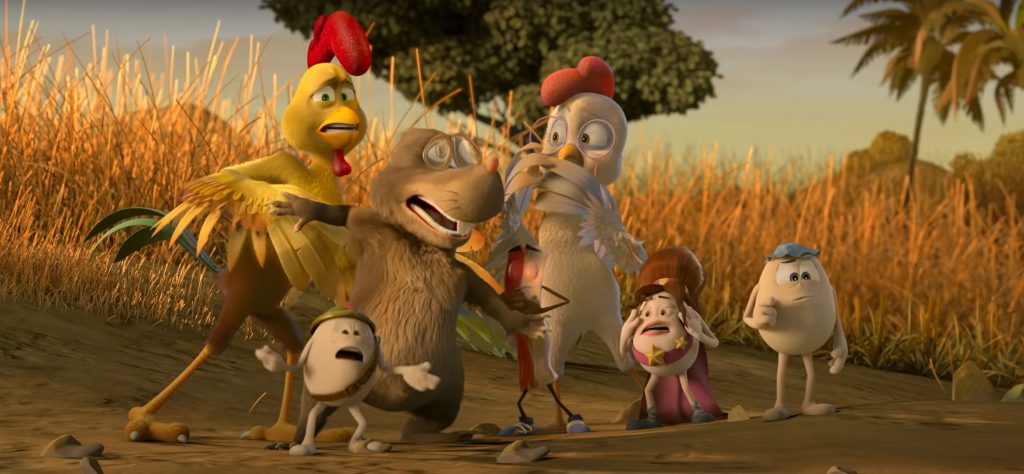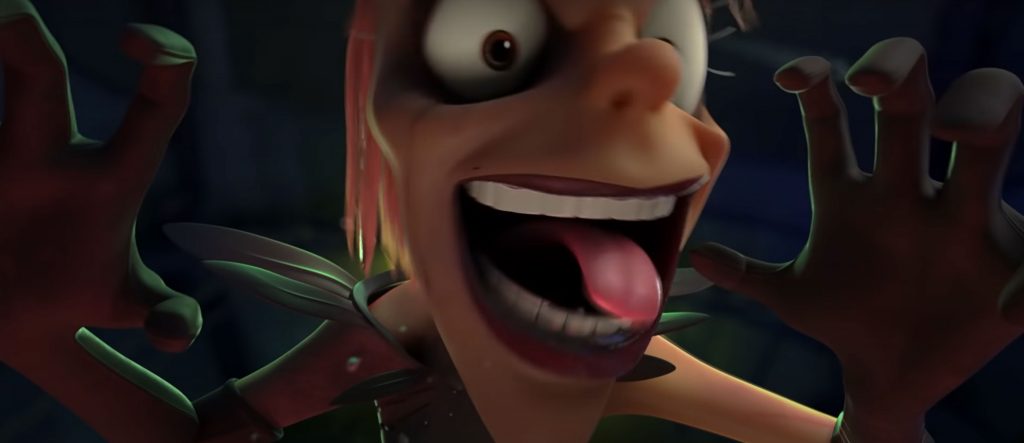April 22, 2022
by Carla Hay

Directed by Ariel Winograd
Spanish with subtitles
Culture Representation: Taking place in various Mexican cities, including Puerto Vallarta and Mexico City, the comedy film “¿Y Cómo Es Él?” features an all-Latino cast of characters representing the working-class, middle-class and criminal underground.
Culture Clash: An angry cuckold decides to get revenge on the taxi driver who is his wife’s lover, and the two men take an unexpected road trip together.
Culture Audience: “¿Y Cómo Es Él?” will appeal primarily to people who are interested in watching silly and unimaginative comedies about men who complain about relationships with women.

Dreadfully boring and sloppily made, the cinematic dud “¿Y Cómo Es Él?” is as about as fun as getting a flat tire, which is one of many predictable things that happen in this road trip movie pretending to be a wacky comedy. “¿Y Cómo Es Él?” is based on the very flimsy idea that a man intent on getting revenge on his wife’s lover (who’s a taxi driver) will decide to take a road trip with him instead, while the taxi driver gets both of them into all sorts of trouble. That’s essentially the entire plot of this vapid garbage. The wife at the center of the love triangle shows up on screen occasionally, almost as an afterthought.
That’s because “¿Y Cómo Es Él?” is just a pathetic excuse to promote sexist beliefs that men who commit adultery by sleeping with married women are just giving in to their male sex drives, while married women who commit adultery are doing it to punish their husbands. One of the movie’s two main characters—a selfish and misogynistic cretin named Jero (played by Omar Chaparro)—literally uses it as an awful excuse for why he’s promiscuous and doesn’t care if the women he sleeps with are married or not.
Jero says in the movie that husbands cheat on their wives because they can, while women cheat on their husbands for revenge. In other words, this sexist fool thinks that husbands should be more offended if their wives cheat on them than wives should be offended if their husbands cheat on them. Women literally don’t have much to say in this very outdated and male-dominated movie, whose lead actress has less than 15 minutes of dialogue.
Directed by Ariel Winograd and written by Paul Fruchbom, “¿Y Cómo Es Él?” (which takes place in Mexico) is based on the 2007 South Korean movie “Driving With My Wife’s Lover,” which was a dark comedy and a far superior movie. “¿Y Cómo Es Él?” (which translates to “And How Is He?” in English) takes all the edge out of the original movie and turns it into watered-down junk that just re-uses the same tired formula of dozens of other forgettable movies about two opposite people who find themselves on a long trip together. Every possible road trip cliché is used in this film, with results that are irritating and unamusing.
In the beginning of “¿Y Cómo Es Él?,” cuckolded husband Tomás Segura (played by Mauricio Ochmann) is on a plane to Puerto Vallarta. He’s on this trip because he knows that his wife Marcia (played by Zuria Vega) and her lover Jero (short for Jeronimo) are in Puerto Vallarta for an adulterous rendezvous. Tomás also knows what Jero looks like because he stares jealously at a photo of Jero that Tomás has on his phone.
At this point in the story, Tomás thinks that Jero is a rich and successful businessman, based on the photos that Jero has of himself on social media. Meanwhile, Tomás is unemployed. Tomás has lied to Marcia by telling her that he’s taking this trip to go to Monterrey for a job interview.
On the plane, a woman sitting next to Tomás asks him if the photo he’s looking at is Tomás’ boyfriend. He says no. The woman doesn’t believe him and says that she’s open-minded about gay people. Just to get her to stop pestering him, Tomás blurts out that the photo is of the man who’s having sex with his wife. This scene is supposed to be funny, but it just comes across as awkwardly performed.
Upon arriving in Puerto Vallarta, Tomás secretly stalks Marcia and Jero at the resort where the two lovers have been staying. Tomás sees for himself that they are indeed acting like lovers in public. Tomás then furthers his mission to get revenge. Marcia works at a data company, so when the rendezvous is over, she goes back to where she and Tomás live, while Tomás stays behind in Puerto Vallarta and follows Jero.
That’s when Tomás finds out that Jero isn’t rich but works as a taxi driver. Throughout this mindless movie, Tomás keeps in touch by phone with a friend named Lucas (played by Mauricio Barrientos) to give updates to Lucas on what’s happening and to get advice. Lucas encourages Tomás to rough up Jero, and Lucas wants to hear all the details if it happens.
Tomás has fantasies of harming Jero in various ways. He follows Jero to a dumpy outdoor fast-food restaurant. Tomás has a taser that he looks like he’s going to use on Jero when he sneaks up behind Jero. There are plenty of other people nearby who could witness the assault that Tomás plans to inflict on Jero. But at the last moment, Tomás changes his mind and runs away.
Instead of tasing Jero, Tomás decides to do some damage to Jero’s taxi that’s parked outside the restaurant. Tomás takes a knife and cuts a deep, long scratch on the driver’s side of the car. And then, Tomás repeatedly stabs the left front tire while he’s standing up, but he’s such klutz that he accidentally stabs himself in the leg.
Tomás passes out from the pain, and then he wakes up to find himself in the back seat of Jero’s taxi while Jero is driving. Jero mistakenly thinks that Tomás was attacked by the person who damaged Jero’s taxi and that Tomás scared off this vandal. Tomás goes along with this wrong assumption. Tomás asks Jero if he can drive him to Mexico City, and Jero says yes.
Tomás still wants to get revenge on Jero, but the movie’s excuse for why Tomás has decided to go on this long road trip with Jero is because Tomás wants to get to know Jero, in order to find out what Marcia sees in Jero. And what do you know: In one of the movie’s very phony-looking scenes, while Jero and Tomás have their first conversation together, Marcia ends up talking to both of them on the phone at the same time without knowing it.
Not surprisingly, Tomás spends a lot of time in the movie desperately trying to hide his true identity from Jero. However, Jero notices how distressed Tomás looks on this trip, so Jero gets Tomás to admit that Tomás is upset because he found out that his wife is cheating on him. Jero, who thinks of himself as a desirable playboy, then brags to Tomás that he can seduce and have sex with practically any willing woman, and Jero doesn’t care if they’re married or not.
Not once does dimwitted Jero think that maybe a jealous husband might come after him for revenge. And one of those jealous husbands could be the same person who just admitted to Jero that he’s angry about his wife cheating on him. Instead, clueless Jero advises Tomás to beat up the lover of Tomás’ wife. This is what’s supposed to pass as comedy in this witless drivel of a movie.
Meanwhile, the filmmakers of “¿Y Cómo Es Él?” try to make the audience feel sympathy for lecherous Jero when he eventually tells Tomás that he’s divorced. Jero blames the collapse of the marriage on his ex-wife. According to Jero, when they were married, she cheated on him with Jero’s then-business partner, who owned a mattress company with Jero. It’s a lousy excuse for why Jero has no guilt or qualms about committing adultery by having sexual flings with married women. Jero is the last person who should be giving marriage advice, but there he is stinking up much of the movie by giving unsolicited and irresponsible marital counseling to Tomás.
This is one of the odious comments about marriage that Jero says to Tomás: “Women forgive adultery. Men don’t.” Jero also says that by the time a married woman commits adultery, her marriage is already dead. But according to Jero, a married man who commits adultery just sees it as a physical act that’s meaningless and separate from love. With this women-hating mindset, it’s no wonder that Jero can’t find true love with a woman.
Tomás isn’t much better than Jero when it comes to being a backwards-thinking dolt. During the course of the movie, Tomás wants to prove how macho he is by trying to inflict serious physical harm on people. In one scene, Tomás tries to poison Jero with antifreeze. In another scene, Tomás punches a doctor in the face when he’s taken to a hospital to treat his self-inflicted stab wound. These slapstick scenes aren’t funny, and they look utterly stupid.
When Tomás and Jero go to a brothel, because Jero says Tomás deserves to cheat on Tomás’ wife, Tomás is reluctant to commit adultery. But Tomás weirdly wants to impress Jero, so when he’s in the bedroom with the hired sex worker (played by Consuelo Duval), Tomás asks her to assault him into unconsciousness and do whatever she wants with him, so it will look like they’ve had sex. Tomás also gives her the option to do nothing, so they can just talk.
In an idiotic movie like “¿Y Cómo Es Él?,” you already know which option she’s going to take, because this movie is filled with ill-conceived scenarios where Tomás and Jero get banged-up, bloodied and bruised. (The prostitute ends up hitting Tomás on the head with one of her high-heeled shoes.) And why should Tomás care so much about what Jero thinks Tomás might be doing in a room with a sex worker? So much of “¿Y Cómo Es Él?” expects viewers to be as dumb as the movie’s characters.
Jero is a big talker who tells Tomás that he’s invested in several business, including a fleet of taxis. Tomás is too simple-minded to ask Jero why Jero is doing regular taxi driver duties if Jero is such a successful business owner. What Tomás finds out the hard way is that Jero owes money to a ruthless investor named Francisco “Frank” Estevez (also known as El Cuate), who has sent some of his goons to track down Jero and get the money back by any means necessary. You know what happens next: generic chase scenes and shootouts. All of the action scenes in “¿Y Cómo Es Él?” are terribly edited.
And where is Marcia during all these shenanigans? She’s seen mostly on the phone with Tomás, who keeps lying to her about where he is and what he’s doing. It all just leads to a very formulaic and unoriginal conclusion that’s easy to predict within the first 10 minutes of the movie or by watching the movie’s trailer. The acting in the film isn’t as bad as the screenplay and direction, but there’s no cast member in this movie who gives an admirable performance. Watching “¿Y Cómo Es Él?” is like eating junk food that leaves a bad taste in your mouth.
Pantelion Films released “¿Y Cómo Es Él?” in select U.S. cinemas on April 22, 2022. The movie was released in Mexico on April 7, 2022, and in Australia in 2020.


